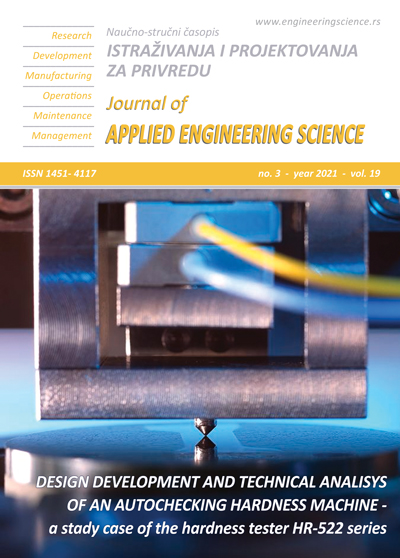BEARING CAPACITY OF FOLDED PLATE FOUNDATIONS IN CLAY SOIL
Abstract
The design of a foundation is inseparable from the type and strength of the soil, for example, clay soils have poor properties for structures due to their low bearing capacity. Therefore, it is necessary to modify the model of a foundation to increase its bearing capacity and one of the popular methods is the application of folded plate on a flat foundation with angles and flange lengths on both sides. Therefore, this research presented its application at different flange lengths of 0.5B, 0.75B, 1B, 1.25B, and 1.5B where B is the width of the flat plate and the results showed the bearing capacity of the folded plate was higher than the flat foundation. Moreover, an increment in the folded length led to a bigger ultimate load and smaller settlement but the ultimate load and settlement were observed to be almost constant at over 1B. This means the optimum variation where the flange length is equal to the foundation width is 1B and it was observed to have increased by 129.52 % using the Tangent Method and 148.4 7% with Butler Hoy Method. Meanwhile, the lowest settlement factor for the folded plate foundation was 0.22 with the highest bearing capacity of 61.19 kN/m2
References
[2] A. Hanna and M. A. El-Rahman, “Ultimate bearing capacity of triangular shell strip footings on sand,” J. Geotech. Eng., 1990, doi: 10.1061/(ASCE)0733-9410(1990)116:12(1851).
[3] R. Rinaldi, M. Abdel-Rahman, and A. Hanna, “Experimental Investigation on Shell Footing Models Employing High-Performance Concrete,” 2018.
[4] B. B. K. Huat and T. A. Mohammed, “Finite Element Study Using FE Code (PLAXIS) on the Geotechnical Behavior of Shell Footings,” J. Comput. Sci., 2006, doi: 10.3844/jcssp.2006.104.108.
[5] N. P. Kurian and V. M. Jayakrishna Devaki, “Analytical studies on the geotechnical performance of shell foundations,” Can. Geotech. J., 2005, doi: 10.1139/t04-110.
[6] D. Esmaili and N. Hataf, “Experimental and numerical investigation of ultimate load capacity of shell foundations on reinforced and unreinforced sand,” Iran. J. Sci. Technol. Trans. B Eng., 2008.
[7] J. E. Colmenares, S. R. Kang, Y. J. Shin, and J. H. Shin, “Ultimate bearing capacity of conical shell foundations,” Struct. Eng. Mech., 2014, doi: 10.12989/sem.2014.52.3.507.
[8] A. Hanna and M. Abdel-Rahman, “Experimental investigation of shell foundations on dry sand,” Can. Geotech. J., 1998, doi: 10.1139/t98-049.
[9] M. S. El-kady and E. F. Badrawi, “Performance of isolated and folded footings,” J. Comput. Des. Eng., 2017, doi: 10.1016/j.jcde.2016.09.001.
[10] S. Timoshenko and S. Woinowsky-Krieger, The-ory of Plates and Shells. New York: McGraw-Hill, 1959.
[11] A. El samee and wael nashaat, “Effect of Pile Spacing On Ultimate Capacity and Load Shearing for Piled Raft Foundation,” Int. J. Appl. Eng. Res. ISSN, vol. 13, no. 8, pp. 973–4562, 2018, [Online]. Available: http://www.ripublication.com.
[12] Y. Y. and A. H. M. Olgun, “Interpreting Load-Settlement Curves of Pile Foundations by Graphical Methods M. Olgun, Y. Yenginar and A. Hanati,” Eurasian J. Civ. Eng. Archit., vol. 1, no. 1, pp. 1–10, 2017.
[13] W. R. Azzam and A. M. Nasr, “Bearing capacity of shell strip footing on reinforced sand,” J. Adv. Res., vol. 6, no. 5, pp. 727–737, 2015, doi: 10.1016/j.jare.2014.04.003.
[14] N. R. El-Sakhawy, T. N. Salem, A. A. Al-Tuhamy, and A. A. El_Latief, “Experimental Study for the Optimization of Foundation Shapes on Soft Soil,” Egypt. Int. J. Eng. Sci. Technol., vol. 21, no. October, pp. 24–32, 2016.
[15] S. Thilakan and N. P. Naik, “Geotechnical Behaviour of Strip Curved Shell,” Int. J. Curr. Eng. Sci. Res., vol. 3, no. 3, pp. 13–17, 2016.

